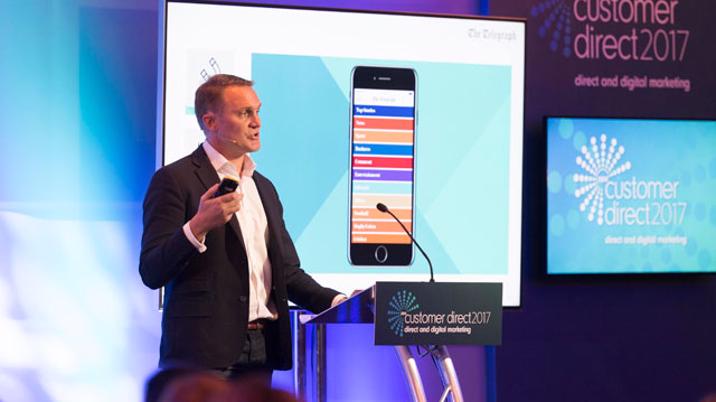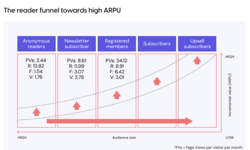
Robert Bridge, previously of Yahoo, was in upbeat form. He was, he said, more confident about the future than he had been in a long time. He saw lots of opportunities ahead.
In a nutshell, the Telegraph clearly feels that its new customer focused strategy is starting to pay off. From his excellent talk, I gleaned seven clear takeaways:
1. Focus on the customer
The Telegraph’s strategy is ‘customer-led journalism’ and ‘customer-led business’. Reaching this point had not been easy, with lots of old-school thinking to contend with and silo walls to break down, but if a newspaper launched in 1855 can make the transition, anyone can. Such has been the transformation that even the design of the print newspaper, for long the preserve of the editor, is now determined by Robert and his team.
2. Get them to log in!
A key part of the Telegraph’s strategy is to chase registrations. Until quite recently, the newspaper – along with most its peers – chased scale. It was a numbers game and a reach of 25 million (across all print and digital platforms) showed that they were playing it quite well. But the Telegraph has since woken up to the fact that scale on its own should not be the goal. Logged-in behaviour and the rich first party data it provides is the future. (Facebook, needless to say, realised this a long time ago.) Such data can then be used to improve both the customer experience and commercial outcomes. The Telegraph makes, said Robert, five times as much revenue from a logged-in user than it does from an anonymous one, and a registered reader is a much better subs prospect. The Telegraph’s target is ten million registrations, though Robert was coy about putting a timescale on that, or on revealing what the current total was.
3. Know your ARPUs
ARPU (average revenue per user) was a key metric. Not all registrations are equal and the sales funnel is a highly segmented process. The Telegraph works the data hard to get the best possible understanding of its users, using modelling techniques and analysis of behaviours and demographics to serve up highly nuanced offers and timely communications. The most profitable segments can drive anything up to 25 times as much revenue as the least. The main aim, though not the only one, is to drive enthusiasts towards subscription.
4. Use social media, but have a plan
The Telegraph is a big player on platforms like Apple News (which they have identified as the single biggest driver into their mobile app), Snapchat and Facebook, but they are open-eyed realists. One of the big challenges over the next few years, says Robert, will be the inability to get first party data from these third-party platforms. The Telegraph’s strategy across all third-party platforms is to move people to the “next best product”, using these channels as a kind of conveyor belt with the ultimate destination being one of the Telegraph’s own properties.
5. Consider a premium model
The Telegraph has now moved away from a simple metered model on its website and now uses a freemium strategy – allowing unrestricted (albeit with frequent pop ups extoling the virtues of registration) access to most of the site’s content, but putting 15% of the content (the best stuff) behind a paywall. (Registration will allow you one premium article per week.) What goes behind the paywall is determined by the editorial team – a decision which helped secure their buy-in to the process
6. It’s not just about subs
Another key plank in the Telegraph’s business strategy is to create a diversified business model, with five or six substantial revenue streams. The most obvious extension opportunities lie in the area of events and ecommerce; Destinations, its travel section, is now one of the top ten travel sites in the world. Employing a super-affiliate model and getting journalists to write the articles, it has become a significant revenue stream, and a model that the company is looking to replicate in the financial services sector.
7. Test, test, test
It wouldn’t be a Customer Direct conference without some mention of testing. A ‘test and learn’ mentality was central to everything he and his team were doing. Test, learn, iterate across all touchpoints, and never stop! If done properly, the approach should result in continual improvement. One area they’ve put a lot of effort into recently was UX/UI testing and their finding so far is that improvements in this area probably have the biggest bearing on subs conversions.
The confident and accomplished Robert Bridge did not pretend that they were getting everything right or that the journey was always smooth, but there was a real sense that he and the Telegraph felt that they had got the direction of travel right and were now enjoying the journey.












